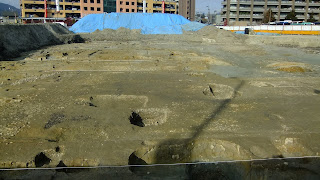Imagine you have walked numerous times past a parking lot near your home for the past six or seven years. Just cars, cars and empty spaces. How boring. Then, one cloudy Saturday morning, on your way to a nearby restaurant, you notice something is different, strange. You realize the car park isn’t there any more. Instead, there is a fence which looks it has sprung up overnight. Suddenly your curiosity is awoken and you take interest. You stop by this new fence, and raise yourself up on your toes to take a better look (you don’t believe you are actually doing this).
The sight, however, is totally unexpected: the cars are gone, the car park is no more. The tarmac itself skimmed off from the surface of the earth like fat from the cooking liquid. All that’s left is the brown patch of earth which has somehow extended to the size of a football pitch. You can even see a few people milling about, apparently taking photos (!). As far as you can make out there is nothing to take snaps of, apart from the flat, square blocks of land, a few lunar-like ‘craters’ and a few longish trenches that give the place some sort of coherence. You must find out what the hell’s going on. You walk round the long fence until you reach a white tent which has been placed at the improvised entrance of what must be, as you begin to suspect, a brand-new archeological site. Soon enough you are handed an A3 size paper with the whole detailed explanation. Alas, you are unable to read the characters, and you do not speak their language very well. So you take a walk around the site, you take a photo or two and when, finally, your curiosity gets the better of you, you start looking for someone to speak to. The choices are limited. You turn to a couple of elderly gentlemen whose animated conversation and their outer appearance – tweed jackets, specs, rucksacks – leads you to suspect they could be knowledgeable or even speak English. As it turns out, you are right as far as their familiarity with the goings on. They tell you in their language (you ask them to speak very slowly) the place has been found to be a thousand-year-old settlement, or rather a group of houses which used to be part of an affluent neighbourhood in the ancient city of Heian-kyō.
The city in question, of course, is present day Kyōto. The Saturday in question is yesterday, December 10th, 2011. The patch of land does exist and has been dug up apparently by the students from the Bunkyo university. Its building is soon to be erected on the very spot (imagine the conservationists canvassing against it and collecting signatures for an ill-fated petition). The site, as my photo attests, is nothing to write home about, yet it should look remarkable to people who have lived for years in the neighbourhood. It is rather exhilarating to know that one thousand years ago here existed a community of aristocrats, and imagine their powdered faces and blackened teeth, their painted eyebrows, their shiny black hair, their multi-layered robes displaying seasonal colours. Imagine walking along a narrow Heian street in the moonlight, and sighting a woman who, having nothing better to do, is watching the shadow of a pine branch, imbued with the sweet futility of existence.
P.S. Today, Sunday, the site is already off-limits! Talk about the world of impermanence.



No comments:
Post a Comment